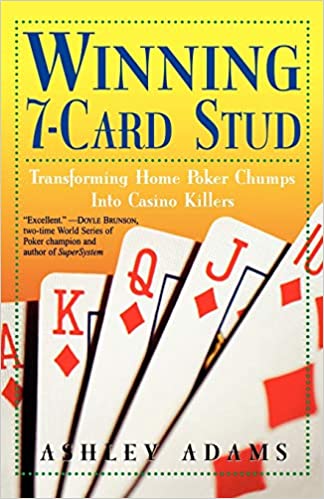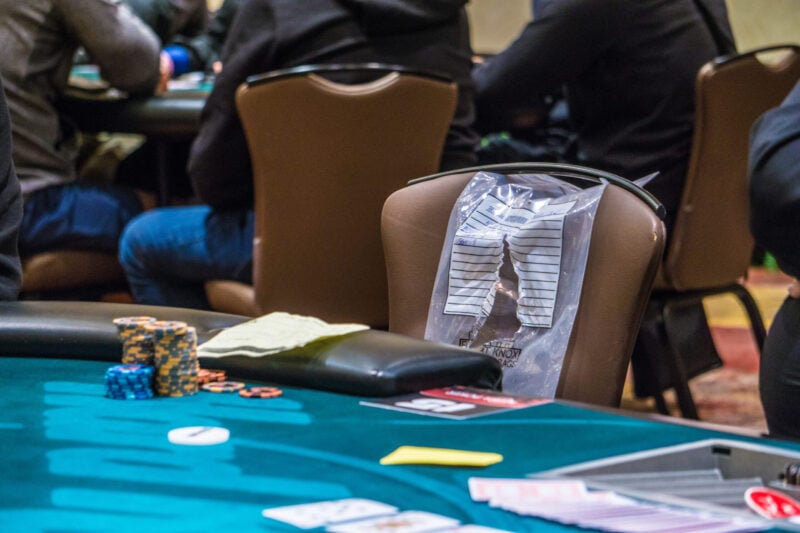During this pandemic, with many of our favorite poker rooms closed down, I’ve noticed the reemergence of home games, and with them, renewed interest in mixed games that include stud. I’ve written prior articles about some of the specifics of Stud and Stud-8 that will help you become a profitable player when those games are spread.
(Ed. Note: Ashley Adams literally wrote the book on Winning 7-Card Stud.)

This is another article along those lines, but here I’m focusing on some of the key mistakes that No-Limit Hold’em players often make, and how you can avoid those errors.
1. Overvaluing AK
AK ranks among the top hands in hold’em. Six cards can turn it into top pair with top kicker. It often makes sense to call or raise with AK preflop. When a hold’em player gets dealt a stud hand with AK, especially if they’re suited, it may seem like the hand warrants at least a call of the bring-in, if not a raise, especially if the king or the ace is exposed.
Don’t do that. In fact, you should generally fold AK in stud.
Without a pair, unless all three cards are suited, or unless there is a queen or jack, AK is a trash hand that should be discarded, even for the bring-in. Three-flushes are playable if no more than two of your suit are exposed elsewhere. Similarly, three big cards are an OK holding to start if they are completely live. But with those exceptions, an unpaired AK is trash. Fold it.
2. Overvaluing low and medium pairs, undervaluing the over-card kicker
In No-Limit Hold’em, 2 2 through 10 10 can often call a modest preflop raise, provided your opponent has a fairly large stack, is generally sticky, or if for other reasons you expect that if you hit a set, you’ll take all or most of his stack. This is generally not true in stud.
In stud, to call a raise, you nearly always need to have a side card bigger than your opponent’s raising card. So, if your opponent raises with (x x) Q, and you have (8 8) 10, you should generally fold.
If, on the other hand, you have (2 A ) 2 or (6 6) A, you might call that raise. You might even reraise to represent a pair of Aces, getting tight or otherwise cautious players to sometimes fold. You have five outs to move far ahead of the hand your opponent is representing. And if you hit your set, your raise would tend to misrepresent your hand, allowing you to further exploit your unsuspecting opponent.
3. Slow-playing leading premium pairs
It’s generally true that you want to play your premium pairs aggressively preflop in NLH, though you may occasionally slow-play them in the interest of misrepresenting your hand and stacking your opponent on later streets. This is rarely the case in stud. Since stud is played limit, you won’t generally have an opportunity to stack your opponent based on his misread of your hand.
Bluffing and slow playing still play a part in this form of limit poker, but since you’re betting in fixed and limited amounts throughout the hand, the value of deception is considerably less than it is in a No-Limit Hold’em game. Accordingly, it’s nearly always correct for you to continue to escalate the betting on the first betting round if you read yourself to have the top pair.
If, for example, you’re dealt (K♠ J♦) K♦ and the bring-in is completed by the player to your right with (x x) Q♦, it almost always makes sense for you to reraise.
4. Overvaluing suited connectors and 3-straights
Suited connectors are complete trash in stud unless the third card is either a premium suited card or is also connected, making a 3-straight. Even if it is connected, the hand isn’t a playable holding unless you have three high cards like J Q K that are extremely live.
In hold’em, there are many situations when you’d want to play those suited connectors, especially in late position in a multiway pot. But in stud, if you have a hand like (7♥ 6♥) T♦, (J♠ 3♣) Q♠, throw it away immediately, even for just the bring-in.
Similarly, if you have (6♣ 7♣) 8♦ and see a couple of any of the following: 9♠, 10♠, 5♠, 6♠, 7♠, or 8♠, and the hand is raised, don’t even hesitate to toss this turkey. Your chances for improvement to a four-straight or a pair and a three-straight aren’t good enough to stand a raise. And if three of those cards are out, toss it even for the bring in.
5. Calling too readily on the first two betting rounds, folding too readily on the last two
In No-Limit Hold’em, you can sometimes justify a loose call with a borderline hand in the early betting rounds because you often have huge implied odds. If you hit that long-shot draw, you have the chance of winning a huge multiple of the early bet you call. But because stud is played limit, this isn’t true. The betting limits prevent large implied odds. Accordingly, it rarely makes sense for you to get out of line with your early calls, as the payoff generally won’t be worth the long odds you’ll face while drawing for a winner.
On the other hand, unlike in No-Limit Hold’em, usually by the time you reach sixth street — and surely by the time you reach the river — the pot is generally inflated to the point that it dwarfs a single bet. In a typical heads-up pot, that river bet is usually only one-eighth or less of the pot. Accordingly, it is usually correct to call that river bet from your opponent unless you’re certain, or nearly certain, that you’re beat.
Imagine you’ve been drawing for a flush in a stud game. You had four opponents who saw fourth and fifth street, then it was heads up to the river. Your opponent, showing (x x) A♠ 6♣ J♠ 4♦ (x) bets on the river. You have (10♥ 9♥) J♥ 6♥ 7♠ 2♣ (10♠).
Your opponent was betting the whole way, representing at least a pair of aces. You were calling, looking for that flush, and then that inside straight as well. Nothing hit except for a weak pair of 10s on the river. You’re probably beaten by a higher pair, if not two pair or a flush. What do you do when your opponent bets on the river?
This is an almost certain call in stud. Sure, you’re probably beat, but unlike in No-Limit Hold’em, where a river bet is often 50% or more of the pot, here the pot is laying you 9 to 1 odds. Unless you’re really, really sure that you’re beat, you must make the call.
As you can see, a profitable No-Limit Hold’em player may bring habits of play to a stud game that, left unchanged, will prove fatal to his bankroll. Learn to correct these five typical mistakes and you’ll be well on your way to being a profitable stud player as well.


